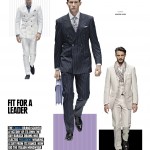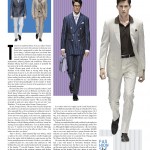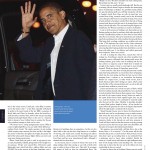


THE AFR magazine March 2010
by Marion Hume
As fashion mourns the passing of the brilliant but troubled designer, Marion Hume considers the tough business decisions that lie ahead.
The king is dead, long live the king. While the court mourns the passing of Lee Alexander McQueen, behind the scenes, courtiers must make plans.
There has, understandably, been no official indication yet on the future of Alexander McQueen – the brand, beyond the statement by Robert Polet, Gucci Group CEO: “The legacy he leaves us is a rich one, and one that we will cherish and honour.” But will they? And how?
McQueen’s mercurial talent was not easy to bottle while he lived (even literally: the reception to fragrances, Kingdom, launched on the designer’s 34th birthday in 2003, and My Queen, in 2005, was lukewarm).
As to how big the McQueen business currently is, Gucci Group clusters the financial data of its niche brands together and 2009 figures will be released tomorrow. In 2008, these brands totalled revenues of £442 million, but the McQueen slice is thought to be one of the thinnest of that pie. Polet has called McQueen stablemate Balenciaga “the fastest-growing brand in the group”, while Stella McCartney has diversified inventively into sportswear, “green” skincare, underwear and fragrances that have found plenty of fans. And McQueen? Beyond the printed dresses and skull scarves that have been flying out of stores this week, a USP included a brave positioning at the cutting edge of technology through hologram imagery and streaming catwalk shows live on the internet, this to embrace seismic changes in the fashion landscape. Had he lived, McQueen could have proved the pioneer in monetarising some sort of live-stream experience. But without his vision, that won’t happen now.
The chatter among the fashion pack is whether a show, scheduled for March 9 in Paris, will go ahead. If it does, this valediction to a lost great will pack both press and buyers alike to the rafters. As to what might be shown, one can only speculate – McQueen has not left a finished collection behind; even designers who will show at London Fashion Week, which starts on Friday, will still be rushing around, adding last-minute outfits. However, no one of McQueen’s stature, within a publicly traded group, works alone. There’s still his team, members of whom – insiders whisper – are certainly talented. Will a collaborative collection sell? For the coming season, absolutely.
Longer term, business analysts predict that Gucci Group will shutter a brand believed to have never performed spectacularly well financially. In contrast, fashion insiders think the brand may hit bigger numbers, should it become more commercial than a rebellious, provocative, living design genius might allow.
But it should be noted that McQueen was apparently more business-minded than his bad-boy image might lead one to expect. François-Henri Pinault, CEO of Gucci Group’s parent company, PPR, recently praised the designer’s business discipline to W magazine, stating that the brand had reached “profitability as planned”, and calling the designer “not only a mature and serious creative director, but also a businessman, since he owns half of the company.” McQueen himself had expressed his desire for a lasting luxury brand, telling W he hoped it would be “here 150 years from now, after I’m pushing up daisies”. You can be sure that in the offices of Gucci Group there will be meetings to determine whether it should now construct a pedestal to a lost design genius, or not.
If this seems like another sign of how money-grubbing the modern fashion business has become, it is, in fact, nothing new. On October 27, 1957, Christian Dior’s coffin lay decked in white flowers in the church of Saint-Honoré d’Eylau, Paris, following his sudden death, aged 52. The most famous couturier in the world had died in Montecatini, Italy, where he had been undergoing a slimming cure in an effort to appeal to a young beau. (It was whispered he had choked to death on an illicit piece of chocolate).
By the time the funeral was over, Dior’s backer, the textile baron Marcel Boussac, whose fortune had funded the launch of “The New Look” in 1947, and who had become immensely wealthy, decided Dior was irreplaceable, that the house built in his name must close. So Dior licensees, all of whom stood to lose lucrative business, gathered at Dior’s HQ on Avenue Montaigne to persuade Boussac to change his mind. Nine weeks later, a 21-year-old called Yves Saint Laurent presented a collection for Dior, which the French press decreed did nothing less than “save France”.
In 1983, the real estate developer Bernard Arnault bought Boussac’s textile firm and with it acquired Dior, which he used as the cornerstone to build the luxury empire LVMH. John Galliano’s first Dior collection was in 1997, meaning he has been at its creative helm longer than the eponymous designer.
As for Alexander McQueen, speculation seems ghoulish now, but you can be sure that when it comes to the business decisions that must soon be taken, the lonely and horrible death of a troubled, brilliant man won’t be allowed to come into it.
AUSTRALIAN FINANCIAL REVIEW
September 2010
WESTFIELD DOWN BY THE OLYMPICS
As the holder of both an Australian passport and that of the host nation of the 2012 Olympics, I’m going to be careful about anything I might say about medal chances. (As if I’d have a clue). But while I’ll stick my neck out and predict that Team GB will beat Australia on the fashion stakes (green and gold is such a tough colour combination), an Australian company already looks so certain to be the all-round winner, it’s awarded itself bronze, silver and gold.
In 2004, those smart Lowys snapped up a huge tract of scrubland on the edge of East London. Then Bingo! Olympic bid won and the perfect location for a Westfield mega mall (especially as, due to restrictions posed by existent railways and canals, almost all access to the Olympic Park will be funnelled via Westfield Stratford City’s shopping streets). The shells of the buildings of the mall are up now (exterior colour scheme; bronze, silver, gold). By the time doors open, a year ahead of the Games, there will be one train a minute to Central London plus parking spaces enough for a catchment area of 4.1 million people out to the East, who up to now have gone well, where? (France?) to mall-shop. Post the Olympics, there will be more than 16,000 new homes here, which equals a whole new neighbourhood.
Londoners have come late to malls. How well I remember, two years ago, listening to a lecture by a retail guru, who pronounced that Westfield London, at the time rising up in West London, would be a great big white elephant. Having adored Westfield Bondi Junction from Day 1, (I really should get “Junger” loyalty points), I knew he was wrong. In its second year of trade, Westfield London is about to exceed £800 million ($1,318,000).
What’s not to like about malls? They are democratic (you can’t have a snooty doorman on the Gucci store when there isn’t really a door), they can carry all price points, you can work them in heels, or pushing a baby buggy and they also offer a safe-yet-glamourous shopping experience to seniors. You can zip in and out or you can linger (although I do think it’s unsporting to charge for parking after two hours, when I’ve at last finished the Coles food shop and want to sit down with a cappuccino).
Westfield Stratford City will be massive – 1.9m sq. ft of retail and leisure space. The only way to really grasp how huge that is would be from a helicopter. So how handy a photographer was doing some aerials shots last week and offered me a ride.
Now, I adore any chance to duck down and run across buffeting grass pretending to be Michelle Obama. And darling, did I not mention how I avoided that tedious limo ride from the Cannes Film Festival to Nice last May by choppering over the Cote d’Azur? But I haven’t had to empty out my pockets before. Or been instructed on sick bag etiquette. Or been strapped in tight as if in a baby seat. It was only when the snapper hopped in behind the pilot and started attaching bungee cords to his equipment, and himself, that it dawned on me we’d be up there with open doors.
Rare is the chance of hovering over the dome of St. Paul’s Cathedral (where I had attended Alexander McQueen’s memorial service just the day before) while flung on one’s side, then going round and round and oh God, round again, with nothing between you and the golden cross but the pilot. An estimated 10 million people will visit the London Olympics. The lion’s share of these will visit both Sir Christopher Wren’s majestic cathedral and, just to the East, the latest shiny cathedral of retailing. Although might I recommend you travel to these separately, by open top bus and closed door train?
ENDS